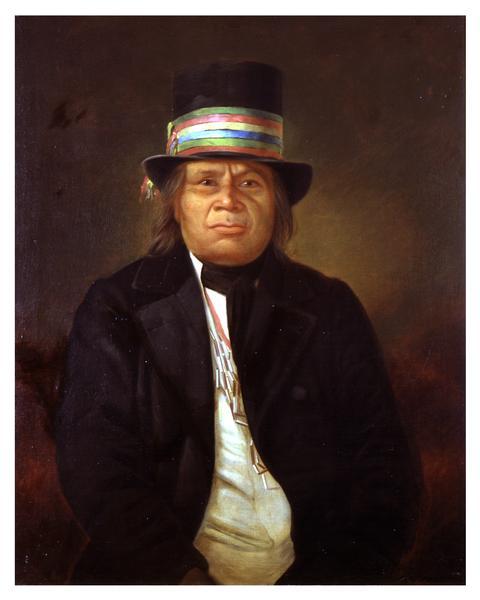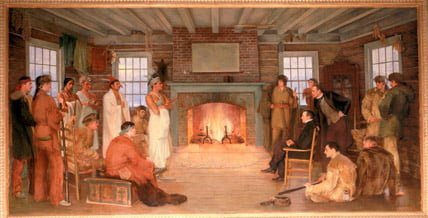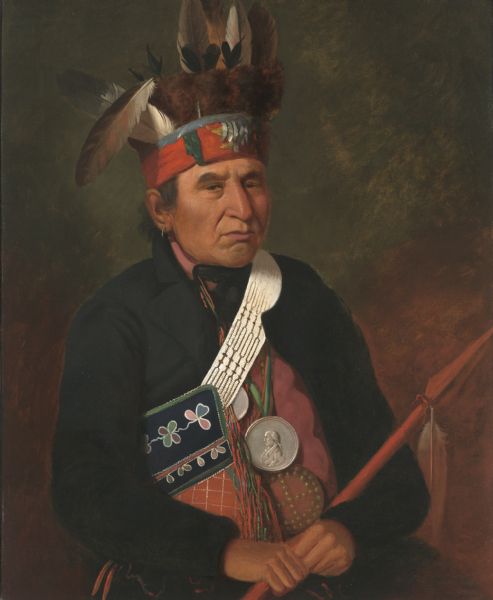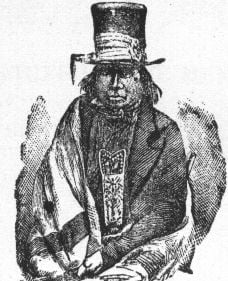
When many years ago Oshkosh, now the second city in Wisconsin, was a hamlet of a few scattered wooden houses along the beautiful forest banks of the deep, wide Fox river, it was known by the classic name of Athens. An election being held to settle on a sure enough name for the future city, the river men, not so much in love with the ancient glory of the city of Athens as they were with the more appropriate name of the old head chief of the Menomonee, came partly in fun and some in earnest and casting the deciding vote gave the budding city the name that has made it known around the world.
Old Chief Oshkosh was entitled to the honor as he was a very worthy man. His worst enemy was his love for “fire water.” He was born in “The Old King’s” village one-half mile up river or south of the old French fort on the west bank of the Fox river, opposite the small settlement at Green Bay in 1795. Like all papooses, after he grew out of the basket cradle strapped to his mother’s back, he learned to fish and hunt with the bow and arrows. He was the grandson of Old King, but was not a chief until he became a warrior. When he came into the world the country about was owned by the Americans, but no government had been established over these tribes, except such as was accomplished by the fur trading Englishmen from Canada. The Americans had a small garrison in the old fort at Mackinaw island at the outbreak of the war of 1812.
Col. Robert Dickson organized a band of Wisconsin Indians, including the Menomonee under their chief, Tomah, with Oshkosh in the party. They proceeded by boats and canoes from Green Bay and easily captured the stockade without any less to either side. During the war the Americans could not repossess the fort. Colonel Dickson, with the Fox river Indians, including the Menomonee under Tomah defended the fort in a hard battle with the Americans to capture the stronghold in 1814. Major Holmes was killed by the Menomonee and a chief, Weekah, of the Menomonee was killed near the same spot. Oshkosh was with this garrison defending the fort and it was not the first real battle he had ever seen. Oshkosh went on the war path to join Tecumseh against Fort Meigs in 1813 and later under Proctor and Dickson attacked the fort Sandusky, so gallantly defended by Cropland; and every where defeating the Menomonee returned home to the Bay. Doubtless he was with the Menomonee war parties who frequently went out against the Chippewa in northern and western parts of the state.
“Oshkosh was of medium size, possessed much good sense and ability, but is a great slave to strong drink and two of his three sons surpass their father in this beastly vice” (Grignon). It was because of a brawl, occasioned by too much drink that he was laid up for a week and died at Keshena, August 20, 1858. The artist Brooks, reached Keshena a day or two before his death, and painted his picture, which hangs in the rooms o£ the Historical society at Madison. The artist lacked good taste in perpetuating this noble red man in the scarecrow clothing some wag had given him. Oshkosh in that plug hat and high colored ribbons may do for a comic almanac, but does scant justice to the supple form of the brave warrior of the Menomonee, who never raised the tomahawk against the white man.
When the Black Hawk war broke out in 1832 the Menomonee had been for many years enemies of the Ojibwa or Chippewa, but made peace with them, on the Chippewa river, encouraged to do so by their desire to join the Americans against the Foxes and Sacs. Colonel Stambough took about three hundred of them up river to join General Dodge’s rangers and frontiersmen protecting the settlers in that war.
Rev. Cutting Marsh saw this Menomonee band on their way up the Fox river and thus describes them:
“They appear, indeed, thoughtless as sheep bound to the slaughter. Their painted faces, ornaments, drums, whistles, war clubs and spears, made them appear, indeed, savage and scar-like. Their songs, uttered from their throat, consisting of deep guttural songs, and the occasional whoop was calculated to snake one feel darkness still brooded over this land removed so far from civilization.” Oshkosh was with them.
There were about sixty Menomonee under Colonel Hamilton, son of Alexander Hamilton, who carne up to the battle of Peckatonica just as it was over. The Winnebago took the scalps of the dead Sacs, but the Menomonee refused to take any, saying they belonged to the white chief, they had not killed them. One authority says of this Indian contingent, after a few days of talking, counseling and “eating up a great deal of beef, they became discontented and departed, frightening the inhabitants of the country through which they returned. They were a cowardly and treacherous set of miserable fellows.”
Oshkosh was present at the payment and treaty held by Governor Henry Dodge in 1836, at Cedar Point at Cedar Rapids, opposite Kimberly. At this treaty the Menomonee conceded a portion of their lands west of Lake Winnebago and Fox river, and were removed to Lake Poygan in town of Poygan in Winnebago county.
The Lost Partridge Boy
The Partridges lived in Vinland. They lost the boy. Having discovered this boy among the Menomonee they claimed it, and a trial was had before Commissioner Buttrick in Oshkosh who decided in favor of the Indian mother Sabah Kom, but the child was taken from the sheriff by Partridge friends and after two years was recovered by the Indian agent down in Indiana and brought to Milwaukee, where before proper legal steps could be had, the Partridges smuggled the child out of jail and he grew up among the whites.
The Indian boy claimed as the lost child of the Partridges was a Menomonee. The speech made by Oshkosh, head chief in 1855, to the editor of the Milwaukee Sentinel and interpreted by Mr. Robert Gringos and Mr. William Johnson, was as follows: “It was at the payment at Lake Pouwaygan, made by Colonel Jones, that this boy was born. I then lived on the Wisconsin river and was notified to come to the payment with my tribe. The roll had all been made up, and the payment was to be made the next day. During the night this boy was born. I was told of it in the morning, and asked Colonel Jones to put his name on the roll. The colonel said it could not be, but if the chiefs were all willing the child should have his share. They were all willing. The boy’s share was given to me, and I gave it to his mother. It is the truth I am telling.”
The boy might resemble his white neighbors, as the Menomonee are a fine appearing people. Cadillac says. of them many years ago, that “the men are very white, and the women also rather pretty and more gentle than those of other tribes.”
“There is no nation in which the men are so well built, or have so good figures as this one.” It was Charlevoix, who said of them, they are “fine looking men, among the most shapely in Canada and taller than the Pottawattamie.”
The Menomonee Indians have resided since first discovered by white men, and still reside between the Wolf river and Green Bay or Fox river. Nicolet, Allouez, Andre and Marquette all met them on the western shore of Green Bay. They advised Marquette not to visit the southern tribes as they were ferocious and would kill strangers and there were demons that would devour him. Before this they had promised to furnish him with a canoe for the voyage. They are reported to have four women to every man, to be good natured, not keen of intellect, selfish and avaricious, but brave warriors, and do not steal or lie. They were great canoe men and fished sturgeon with a spear. Their language was Ojibwa, but they had a secret language of their own besides.
Their war parties traveled far. They aided the French at the battle of Detroit against the Fox and Mascoutins; joined Charles De Langlade in his journey to Fort Du Quesne, where they ambushed and killed Braddock on the Monongahela; and were with Langlade fighting under the banner of France when Montcalm fell before the plains of Abraham. And they fought under the “Bravest of the brave,” in Burgoyne’s invasion and at Bennington. They refused to join Pontiac’s conspiracy, but Old Carron, the head chief, guarded and conducted the English garrison safely away from the post at Green. Bay, for which service he had a medal.
Two centuries ago they were said to number but eighty warriors, or 400 people, and since have grown to upwards of 4,000 people. In 1820 when the New York Indians, under Eleazer Williams’ guidance, made a visit to Green Bay to treat with the Menomonee for lands, that tribe claimed to possess a good portion of northern Wisconsin, which they could not have made good as against the Winnebago and Chippewa. But they pretended to sell the New York Indians a joint right to a five mile strip of many miles in length, which, however, was never occupied by them, nor conceded by the government.
The Menomonee and Fox and Sacs were friends on Green Bay and the lower Fox river, but about seventy-five years ago or earlier some Menomonee joined the Prairie du Chien and killed their chief, Kettle. Soon after, the ‘Menomonee being all very drunk in their camp on an island in the river near Prairie du Chien, the Foxes fell on them and killed great numbers before being driven away.
After the Americans maintained an army post at Prairie du Chien, which was after the war of 1812, the Menomonee often visited there and frequently wintered on the Mississippi river.
In 1836 such a band was visiting there, when in a drunken fray a Menomonee had killed a Winnebago. By the savage law he must either be given up or his life must be taken by his own tribe. A council was held and instead of the Menomonee the chief of the tribe offered them whiskey. The Winnebago could not resist the temptation and ten gallons of whiskey was produced which was drank by all the parties over the grave. The first Menomonee chief mentioned was Kioulouskoio, in 1695, since which time numerous celebrated names have sprung up in the tribe, eight or ten holding sway at the same time.
The old king bore up for nearly a hundred years, the name of Clia Kau Cho Ka ma. He was the grandfather of Oshkosh “the brave,” and Osh Ka He Now Niew his brother, called “the young man,” who was born in 1806.

“The old king” died in 1821, while on a visit to Prairie du Chien with some of his relatives. He was then 100 years old and nearly blind. He was a man of good sense, but no public speaker, and was highly esteemed by his nation. His certificate as grand chief, given by Governor Haldimond of Canada, in 1778, is in the rooms of the Historical society at Madison.
In 1728 when the French and Indian army came against the Wisconsin Indians, they attacked a Menomonee village on the west shore of Green Bay. At the same time the Sacs were located on the present site of Green Bay. “Old King’s village” was half a mile up river from the old French fort at the bay, until the Menomonee were removed to Poygan in 1836, and must have been located about 1740. It was there in 1763 and hence was about a century old. His grandsons, Oshkosh and “young man,” led their tribe to Poygan in 1836. and Oshkosh resisted many attempts of the government to induce them to remove west of the Mississippi river, and in 1856, led their tribe up the Wolf river to their present reservation located within a few miles of their ancient home on the banks of the bay.
Old Carron or Vieux Carron, said to be the son of a French trader, was born about 1700 and died in “the old king’s village” in 1780 He was a fierce old warrior, having served in all the French wars and with Montcalm on the heights of Abraham. He assisted Lieutenant Gorrill, with the English garrison, to escape from the Green Bay post in 1763, when the Pontiac Beaver war was on. Sir William Johnson sent a certificate to Ogemaunee for this service which must have been his Indian name. He was for many years head orator. His children were Glade, Tomah, Shequanene, Iometah and three daughters.
Glade, or Glode, or Con-note, the son of old Carron, was born in 1739. He was the orator of the tribe, and a fine speaker, who made sensible remarks and to the point. He was a very successful hunter and trapper and great warrior, going on the war path for the French, and fought on the plains of Abraham and he took an active part with the English in the American Revolution. In the fall of 1803 he was on a hunt with his two wives and five children and all contracting some malady, they all died, except two children. His only surviving son was Carron, made chief at Little Buttes des Morts the same day with Oshkosh. Glade was a tall and well proportioned man of great personal prowess. At ball play when two or three would pitch on him to keep him back he would dash ahead not seeming in the least to mind them. He was a splendid athlete.
Tomah, the most noted of the sons of old Carron, was born in 1752 at the “old king’s village” opposite Green Bay, and died in the summer of 18 17 at Mackinaw at sixty-five years of age. He was six feet tall, spare, had dark eyes and handsome features, was very prepossessing, with lordly bearing. He looked every inch a king-Grignon said he was the finest looking chief he had ever seen. His speeches were not long, but pointed and expressive. He was firm, prudent, peaceable and conciliatory, was sincerely beloved alike by white and red men. He was the best deer hunter in the tribe. One city is named for him. He was often called Carron. Was for many years head speaker. Three of Tomah’s sons were chiefs. One was Mau Kau tau Pee, who was with McKay at the capture of Prairie du Chien in 1814 and died in 1820 Another son of Tomah was Chief Josette Carson who succeeded him as head speaker and died in 1831, and another son of Tomah was Chief Glade, named for his uncle. He spoke French well, had no lore for public affairs and died in 1848.
The above Josette Carson had two sons, chiefs in r857. One was Keshenah, born in 2829 and for whom the present reservation town is named. Another was Shawneon (Shononee) or the “Silver” born in 1827. The city and county of Shawano are named for him.
Iometah, head war chief, brother of Tomah and son of old Carson, born in 1772, was in 1859 at eighty-seven years of age the only surviving son of old Carson and then he was strong enough to walk 200 miles to Milwaukee. Was on the war path in the war of 1812. Was a great hunter. He was noted for paying his debts, a rare trait of character. Said to have been an honorable man and worthy representative of the Indian in heroic days. His picture by Brooks hangs in the Historical society’s rooms.
There was a Carron made chief with Oshkosh in 1827 who was a son of Glade and grandson of old Carron. He was born in 1803 and alive in 1858.
It is not true that Colonel Stambough gave his name to the chief as his father bore it before him, who, though not a born chief, exerted great influence over the tribe and was regarded as such. His son Kaush Kau No Naive or the “Grizzy Bear” served under Tomah in the war of 1812 and after the death of Tomah in 1817 was with Josette Carron chosen orator of the nation. He served under Colonel Stambough against the Foxes and Sacs in 1832 and died in 1834, aged fifty-two years. About 1830 he was with Colonel Stambough when he went with the Menomonee to Washington to make a better treaty for lands and annuities. While there it is reported of him that viewing the historic paintings in the rotunda of the capitol, he pointed to the illustration of the landing of the Pilgrims and said: “There Injun give white man corn,” then to the Penn treaty, “There Injuns give um land,” then to Pocahontas saving the life of Captain Smith, “There Injun give um life,” then to a picture of Daniel Boone with his foot on the neck of a savage and plunging his knife into another, and said, “There white man kill Injun.” He was a savage of great personal dignity. His other name was “The Great Packer.” After his death he was succeeded by his son, Wau Pa Men or “the Corn,” who was succeeded by his brother, another son of “Grizzly Bear,” Ok ke ne bo way or “The Standing Land,” who was born in 1820.

Among the chiefs of the Menomonee who led their family to the heights of Abraham, were Osauwishkeno, or the “Yellow Bird,” and Ka Cha Ka wa she Ka or “The Notchmaker. “
Souligny was a mixed blood born 1783. His grandmother was the reputed daughter of Souligny, an early French trader who was a son-in-law of Sieur de Langlade’s second handed wife. This chief was highly regarded by the tribe and the white. He led his band with the English in the war of 1812 and the Stambough expedition in 1832 and was a stout, good looking man, with one eye gone. He was alive in 1858 at seventy years of age, when he walked 200 miles to Milwaukee. His portrait, painted by Brooks, hangs in the Wisconsin Historical rooms at Madison.
Other chiefs in 1858 were Ahkenotoway, who was born in 1821, and Cosagascegay, who was born in 1813.
The chief of the mixed Menomonee band at Milwaukee was Onaugesa, who had married a Pottawattamie woman. He was a brother of Mrs. Joseph Roy of Green Bay and often visited her as early as 1784. Unlike most of the Milwaukee band, he was a kind and worthy Indian. He died there about 1840.
One of the historic Menominee chiefs was We Cha Ne Qua, or “the Rubber,” who is said to have protected an American during the war of 1812 by guarding his escape from Green Bay to Mackinaw. He was chief of a small band and a brother to Oshaw wah nem or the”Yellow Dog,” and cousin to L’ Espagnol, who distinguished themselves in the killing of Major Holmes at defense of Mackinac in 1814. The old chief who formerly lived at the present site of Marinette long prior to 1791 was Te Pak a ne nee.
Another chief of distinction was Ap po mich sha, or the “White Elk,” who also fought at Fort Nleigs under Tecumseh and with Proctor were defeated at Sandusky.
Another noted chief at the capture of Mackinac was ”Pe wan to not” and others who were on the war path in 1832 against the Foxes and Sacs were Old Poegonah and Wau nau ko and La Mott.
Others not named who were engaged in the McKay capture of Prairie du Chien were Chiefs Ma cha nah or “the Hairy Hand,” Kish kou nau Kati Hom or “the Cutting Off,” “Yellow Cloud” and Wau nau ko after whom Winneconne is named.
Another chief was Lapone, with a small tribe in 1836 located in a village named Waukau across the Fox river from Delhi, from which the village of Waukau gets its name.
The first missionary among the Menomonee was Alouez in 1669, since which date there have been more or less, always under the teaching of some good priest, among whom have been Andre, Marquette and others, and later Mazzuchelli established a school for them, and Rev. Van Den Broecle had his mission for them at Little Chute They now have their churches, schools and missions; yet still the weird songs of the sighing winds through the shaded forest with its carpet of trailing arbutus and the sun and moon and all the savage superstition inherited from untold ages, by the children of the wild woods, retains its spirit influence over them, and while they chant their catechism they still propitiate the Manitou of the red man with offerings of tobacco and presents and make provision for the journey of the dead to the happy hunting grounds.

